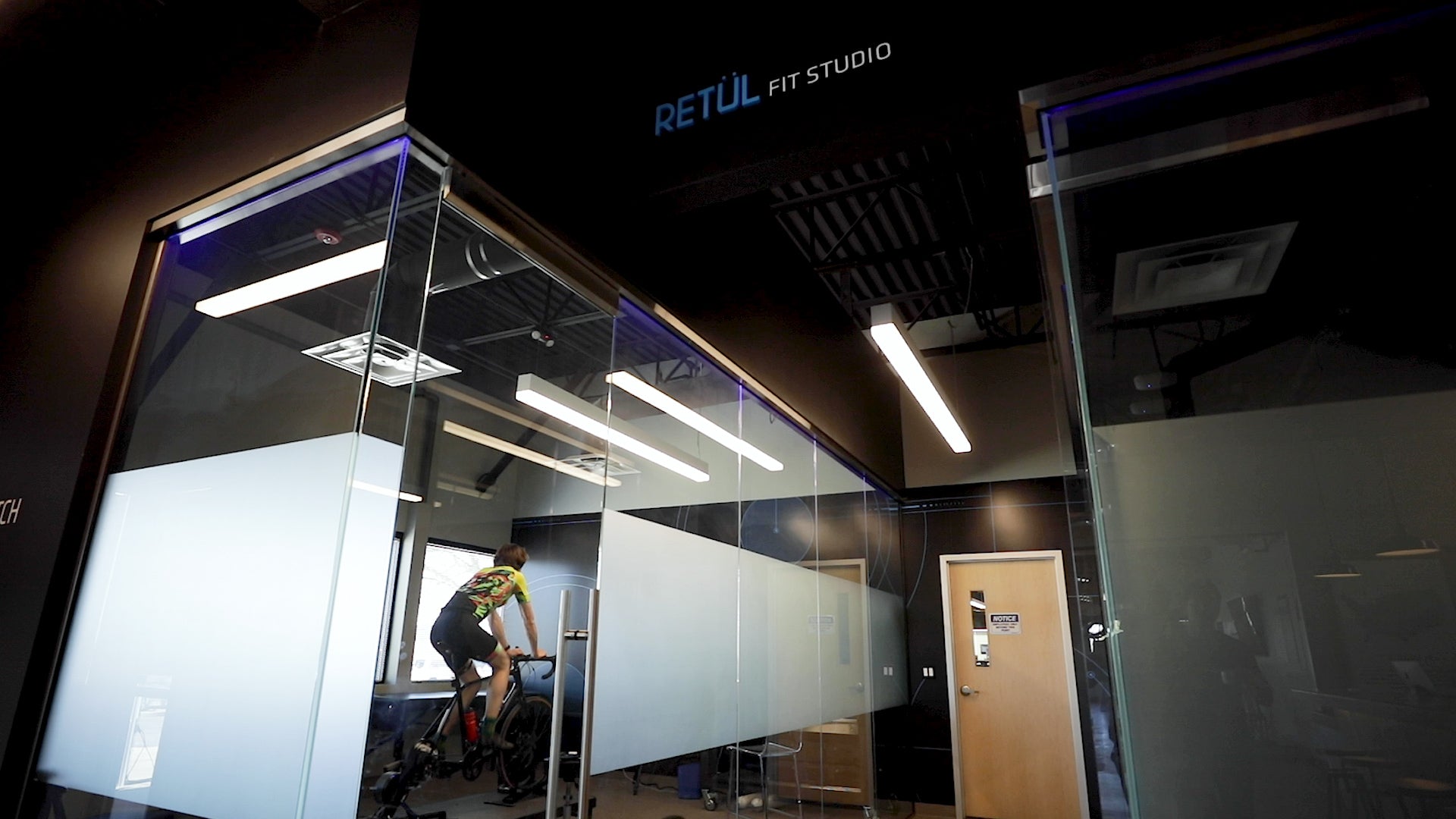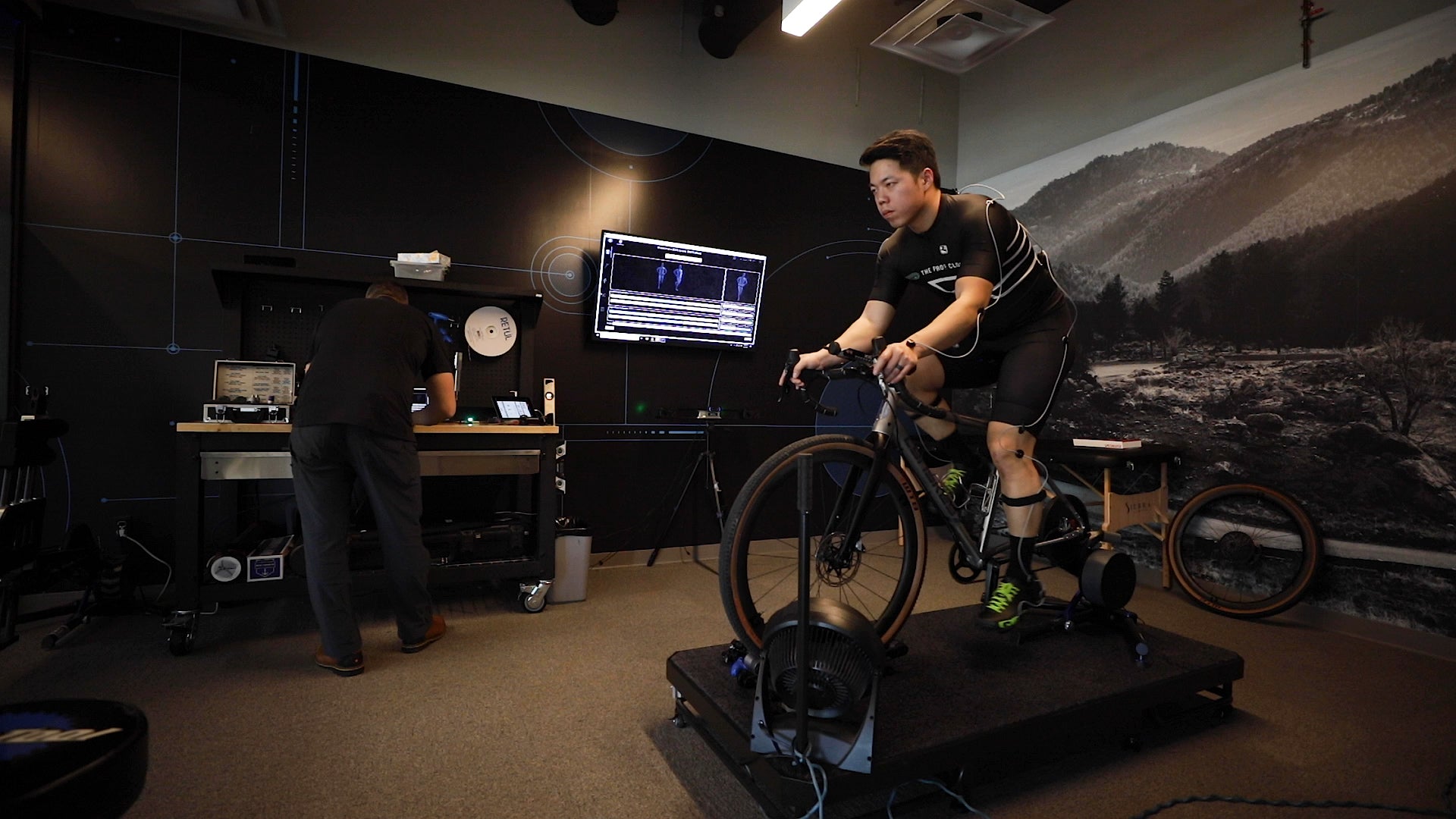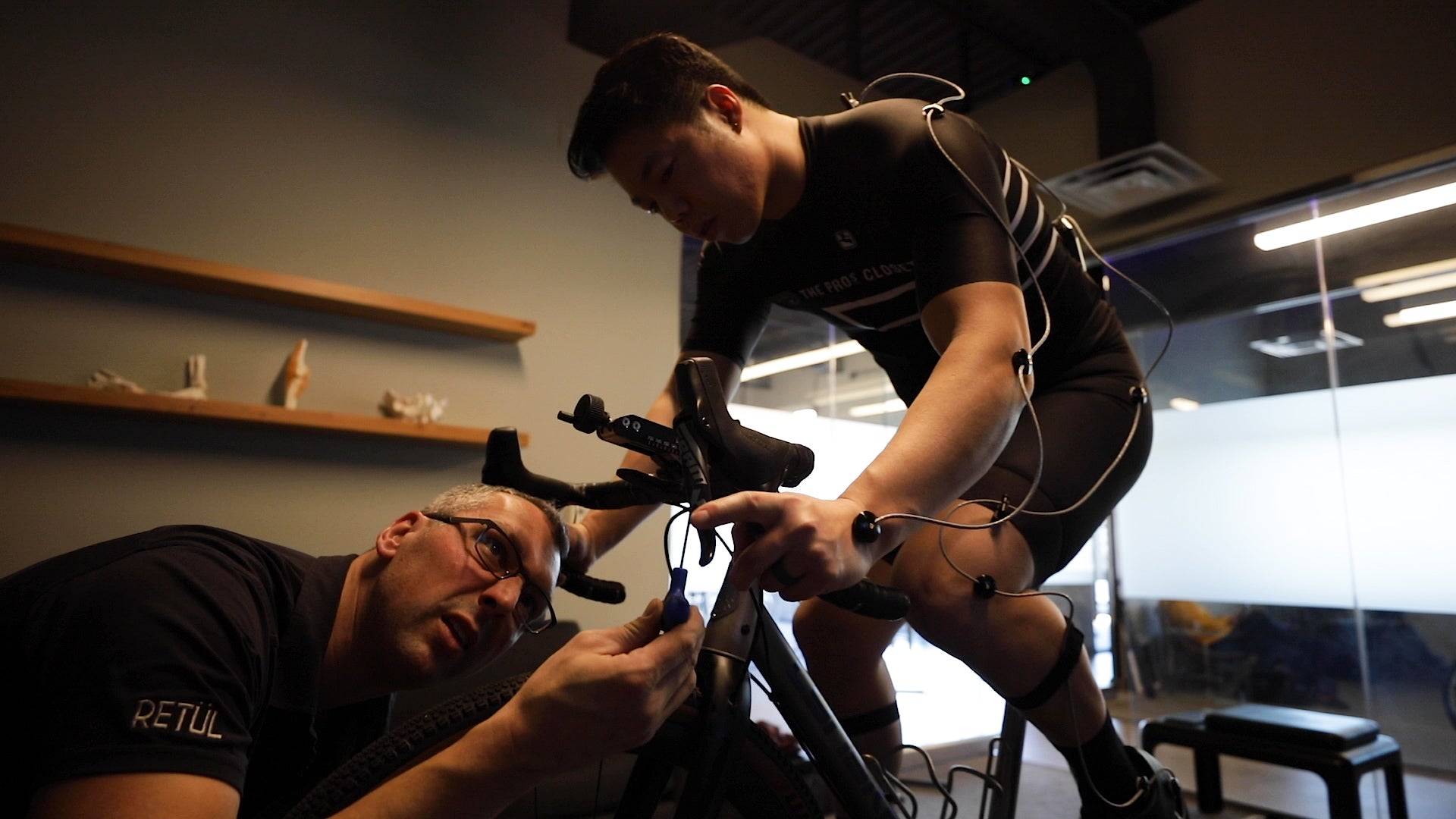I began cycling seriously over 10 years ago, but I have never gotten a "real" bike fit. I’ve always been hesitant to spend the money, and I figured I could set up a decent fit on my own. I just rode on and dealt with any discomfort.
Now that I'm older, I’ve become a lot busier, gained weight, lost flexibility, and drifted far from my physical prime. Then, this year, I got the opportunity to race Dirty Kanza, the world’s premier gravel event. I’ve never ridden 200 miles in my life. As I added more weekly training miles (I call them "panic miles") I couldn't shake an annoying amount of butt, back, hand, and foot discomfort on my new gravel bike. Even more concerning was a growing pain in my right knee.
I decided it was finally time to seek professional help. So I went to the fit experts at Retül. Retül uses 3D motion capture technology to fit riders. It is one of the most technically advanced fit systems on the market. Several professional race teams use it to maximize the performance, comfort, and efficiency of their riders and reduce the chance of injury.
Even if you’re not doing an ultra-endurance event, a professional bike fit can improve your riding and allow you to get the most out of your bike. This was my experience.
*Note: I visited Retül prior to the developing Coronavirus/COVID-19 crisis in the U.S. Racing plans may change as events like Dirty Kanza get postponed or canceled. But at least I have a good bike fit for the future!
Getting started
 Retül started right here in Boulder, Colorado, but you can find other Retül locations with trained fitters around the world. I went to Retül’s fit studio and headquarters at the Specialized Experience Center in Boulder and scheduled a fit with Jason Williams, lead fitter and sports scientist on the Specialized Human Performance team.
Retül started right here in Boulder, Colorado, but you can find other Retül locations with trained fitters around the world. I went to Retül’s fit studio and headquarters at the Specialized Experience Center in Boulder and scheduled a fit with Jason Williams, lead fitter and sports scientist on the Specialized Human Performance team.
Jason asked what specific things I wanted to focus on in our session and I explained how I wanted to set my gravel bike up for maximum comfort during a 200-mile event. We covered significant injuries and problem areas I wanted to address like my knee.
For the fit, I brought my bike, riding gear, and shoes. I also had to avoid sunscreen or lotion on my arms and legs on the day of the fit to ensure LED markers would stick to my skin.
The pre-fit assessment
 First, I performed movements and stretches in the studio so Jason could observe how I moved off the bike. He also performed other testing protocols on a kneeling bench and table. His observations were all documented in the Retül software.
First, I performed movements and stretches in the studio so Jason could observe how I moved off the bike. He also performed other testing protocols on a kneeling bench and table. His observations were all documented in the Retül software.
The findings were interesting. My feet are quite different from each other, with my right being somewhat flatter and less pronated than the left. I also have slightly bowed legs combined with tight IT bands that pull my legs away from the midline of my body. It was enough for Jason to recommend aggressive foam rolling of my IT bands and even a sports-specific physical therapist to work on releasing them.
I also learned that I have a wide butt. Using a Retül DSD (Digital Sitbone Device), we measured my sit bones at 130mm. Ideally, you should have around 1cm of additional saddle width on either side, meaning I should be on a 150mm or wider saddle for optimal comfort and support. The 143mm saddle I’ve been using for the last decade has worked, but it could be better. When I got home I immediately ordered the 155mm version of the same saddle. Over the course of a 200-mile race, I’m sure my ass will thank me.
My shoes were also an issue. I was using “high volume” Giros, yet it still wasn’t enough because the outside edges of my feet extended past the sole. I needed truly wide shoes, and based on Jason’s recommendations I decided to switch to a wide model produced by Lake.
 To give my pronated and asymmetrical feet better support, I also got custom footbeds. The molding process took less than 30 minutes and I can confidently say these are the most comfortable and supportive footbeds I’ve ever worn.
To give my pronated and asymmetrical feet better support, I also got custom footbeds. The molding process took less than 30 minutes and I can confidently say these are the most comfortable and supportive footbeds I’ve ever worn.
One thing that truly impressed me during this was Jason’s restraint from telling me to spend any money. They sell Specialized products here, but never once did he make a marketing pitch. He explained in detail why he thought my current equipment was suboptimal. But he suggested I try riding my bike with the new fit more before making purchases.
I made my gear purchasing decisions in my own time and can report that his recommendations were all spot-on. My feet and butt have never been happier. Honestly, it was a huge relief to know for sure what I needed before spending money. Trial and error can work, but it's never fun.
The bike-fitting process
 For the bike fit, my bike was mounted to a stationary trainer on a rotating platform. LED markers were then stuck to eight anatomical points on my body. These flashing markers are captured by the Retül Vantage Motion Capture system. This system collects real-time, 3D data from each pedal stroke which is then compiled into Retül’s fit software so Jason can look at the numbers and adjust my position accordingly. With the trainer, he can also see my power numbers and deduce if a change is improving my efficiency or power.
For the bike fit, my bike was mounted to a stationary trainer on a rotating platform. LED markers were then stuck to eight anatomical points on my body. These flashing markers are captured by the Retül Vantage Motion Capture system. This system collects real-time, 3D data from each pedal stroke which is then compiled into Retül’s fit software so Jason can look at the numbers and adjust my position accordingly. With the trainer, he can also see my power numbers and deduce if a change is improving my efficiency or power.
The software compares my movement patterns and body angles to ideal ranges based on decades of data collected from thousands of riders and professional bike fits. Jason was quickly able to see where I fell out of range and could prescribe adjustments to improve my fit.
My leg extension was slightly high. He adjusted my saddle position slightly to improve this, and the change amounted to just over 5mm. It’s a modest change but over a 200-mile ride, it may pay huge dividends.
Other than my saddle position, it was clear that there were two major issues with my current fit. First, my cockpit was far too cramped. Second, my knees did not track straight.
My cramped cockpit was obvious to Jason because my back angle was too high. And it was clear through the motion-capture image of my body that my arms were too straight and I had excessive weight on my hands. With my internet-acquired fit logic, I had surmised that building my bike with a shorter stem would lead to a more upright and comfortable riding position. Makes sense, right?
 Using an adjustable stem, Jason was able to show me how mistaken I was. By extending my stem length 20-30mm (which is a massive amount) we discovered I was able to bend my elbows more and relax down into my position. I was stretched out more and a bit lower, but also more comfortable because my weight was supported more by my core rather than my arms. This was a huge discovery. For me, it was so counterintuitive that I doubt I would have figured it out on my own.
Using an adjustable stem, Jason was able to show me how mistaken I was. By extending my stem length 20-30mm (which is a massive amount) we discovered I was able to bend my elbows more and relax down into my position. I was stretched out more and a bit lower, but also more comfortable because my weight was supported more by my core rather than my arms. This was a huge discovery. For me, it was so counterintuitive that I doubt I would have figured it out on my own.
The 3D motion capture cameras showed that my knees tracked outward excessively as they moved up. My poor flexibility and tight IT bands were the cause. Coupled with the lack of foot support my old shoes and insoles had, it was the likely source of my knee pain.
We tried different pedals and pedal washer set-ups on my bike and examined how it affected my movement. Through testing, we found that around 14mm of additional stance width significantly improved my knee tracking. To achieve this, I decided to use a 5mm Long Spindle Kit and two 1mm pedal washers (+7mm on each side) with a set of Crank Brothers Candy 7 pedals.
The Retül Zin tool and fit report
Once we had dialed in the perfect fit for my bike, Jason used the Zin tool to record the changes. The Zin tool uses the 3D motion capture cameras to create a digital map of my final bike set-up. The tool is placed at different locations of the bike to measure where they are in space. The measurements it takes are extremely accurate.
This data is used to generate a complete fit report, a PDF that details everything Jason noted in my pre-fit assessment, and measurements for the touchpoints on my bike, as well as key geometry measurements like frame stack and reach. This allows me to reference my numbers if I ever need to replicate my set-up when it comes time to purchase a new bike in the future.
Final thoughts
In total, the Retül fit took about three hours. Was it worth it? Yes. I’ve been riding my new fit for two weeks now and they’ve been the first two weeks where my knee hasn’t been sore the whole night after a hard set of intervals. The insoles and shoes, combined with the work Jason did on my cleats and pedal stance have, so far, been like magic. My hands ache less and have stopped going numb during longer rides.
With poor weather and my current child care situation, I’ve also been riding my trainer a lot. I find that stationary trainers really accentuate bike fit issues because you’re unable to move as you do outdoors. It is the most comfortable I’ve been in years, and it has renewed my motivation.
A Retül fit starts at $350, so it isn’t inexpensive. But compared to a bike that costs several thousand dollars it’s really not crazy. It’s cheaper than a lot of upgrades I’ve bought on impulse. And for a tool that I’m going to be spending hours on at a time, many days of the year, the cost of a fit is small for a huge amount of gain.
There are other fit systems out there, and several different fit philosophies. Retül is just one of many. Is it the best? Plenty of riders, including pros, think so. It was best for me. I love the detail, the technology, and the thought process behind what they do. But as long as you can find a good fitter who can improve your comfort in performance on the bike, that’s the most important thing.
Have you had a professional bike fit? How was your experience? Let us know in the comments!

